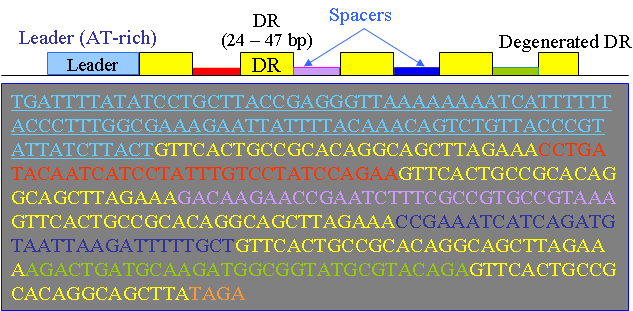Welcome to CRISPRs web server. This site acts as a gateway to publicly accessible CRISPRs database and software. It enables the easy detection of CRISPRs in locally-produced data and consultation of CRISPRs present in the database. It also gives information on the presence of CRISPR-associated (cas) genes when they have been annotated as such.
This web site is the product of an original work by Ibtissem Grissa (PhD thesis Paris University), improved by Christine Drevet, and presently developed by David Couvin.
Please cite :
CRISPRFinder : a web tool to identify clustered regularly interspaced short palindromic repeats.
Nucleic Acids Res. 2007 May 31;
The CRISPRdb database and tools to display CRISPRs and to generate dictionaries of spacers and repeats. BMC Bioinformatics. 2007 May 23;8(1):172 ;
CRISPRcompar : a website to compare clustered regularly interspaced short palindromic repeats. Nucleic Acid Res. 2008 Jul 1
What is a CRISPR?
CRISPR are direct repeats found in the DNA of many bacteria and archaea. The name is an acronym for Clustered Regularly Interspaced Short Palindromic Repeats.
These repeats range in size from 23 to 47 base pairs. They usually show some dyad symmetry but are not truly palindromic.
The repeats are separated by spacers of similar length. Spacers are usually unique in a genome. Some spacer sequences match sequences in phage genomes; it is proposed that these spacers derive from phage and subsequently help protect the cell from infection.
The CRISPR repeat array evolves rapidly.
More details.
What is a "questionable CRISPR" ? When will it stop being questionable ?
There are two kinds of "questionable" CRISPRs:
- Small CRISPRs, i.e structures having only two or three DRs
- Similar structures like particlar kinds of tandem repeats (not eliminated) or structure where the repeated motifs (DR in CRISPR) are not 100% identical.
They stop being questionable if the DR consensus is found elsewhere in the database in a convincing CRISPR.
Many of these structures are not true CRISPRs, and they need to be
critically investigated. One way to "critically investigate" is to see if
the questionable CRISPR seems to be within a coding sequence. CRISPR are
usually non-coding, and do not belong to genes. An other way is to check
the internal conservation of the candidate DRs, and the divergence of the
candidate spacers. More definitive evidence might be provided by the
typing of a collection of strains from this species. Some bench work is
needed there.
I did a blast of spacers, what does a match mean ?
A match with the spacers database means that the queried sequence exists
as a spacer in the CRISPR database. If the query is an questionable
spacer, such a match may suggest that it indeed belongs to a true CRISPR.
When "blasting" against the whole public databases, which is the default
action, at least one match is expected, corresponding to the cognate
locus. A secondary, unrelated match, may indicate the origin of the
spacer. As shown in different reports, spacers seem to come from foreign
sequences, most often phages.
What is the CRISPR Id number ? How is it produced ?
It is derived from the NCBI Refseq of the related genome followed by the
number corresponding to the occurrence order of the CRISPR in the
sequence. Individual spacers are also consecutively numbered. Identical
spacers occuring in different strains will be given different Ids. Such
spacers are listed in the "utilities" page.
Is there any way to search the database using key words (a general query tool) ?
Not yet. We have not seen a practical use for such a tool.


